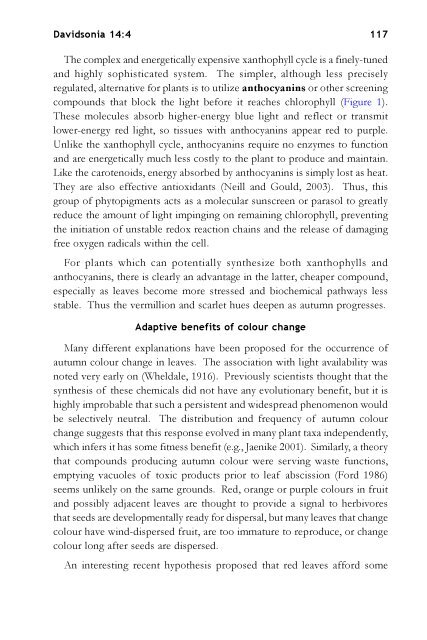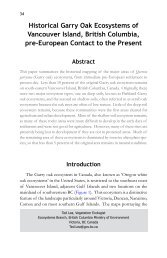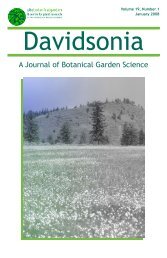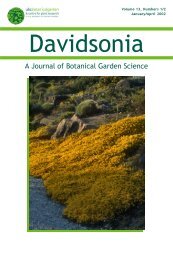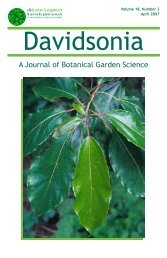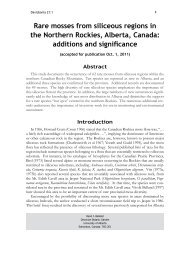pdf wkg Dav.14-14 - Davidsonia
pdf wkg Dav.14-14 - Davidsonia
pdf wkg Dav.14-14 - Davidsonia
You also want an ePaper? Increase the reach of your titles
YUMPU automatically turns print PDFs into web optimized ePapers that Google loves.
<strong>Davidsonia</strong> <strong>14</strong>:4<br />
117<br />
The complex and energetically expensive xanthophyll cycle is a finely-tuned<br />
and highly sophisticated system. The simpler, although less precisely<br />
regulated, alternative for plants is to utilize anthocyanins or other screening<br />
compounds that block the light before it reaches chlorophyll (Figure 1).<br />
These molecules absorb higher-energy blue light and reflect or transmit<br />
lower-energy red light, so tissues with anthocyanins appear red to purple.<br />
Unlike the xanthophyll cycle, anthocyanins require no enzymes to function<br />
and are energetically much less costly to the plant to produce and maintain.<br />
Like the carotenoids, energy absorbed by anthocyanins is simply lost as heat.<br />
They are also effective antioxidants (Neill and Gould, 2003). Thus, this<br />
group of phytopigments acts as a molecular sunscreen or parasol to greatly<br />
reduce the amount of light impinging on remaining chlorophyll, preventing<br />
the initiation of unstable redox reaction chains and the release of damaging<br />
free oxygen radicals within the cell.<br />
For plants which can potentially synthesize both xanthophylls and<br />
anthocyanins, there is clearly an advantage in the latter, cheaper compound,<br />
especially as leaves become more stressed and biochemical pathways less<br />
stable. Thus the vermillion and scarlet hues deepen as autumn progresses.<br />
Adaptive benefits of colour change<br />
Many different explanations have been proposed for the occurrence of<br />
autumn colour change in leaves. The association with light availability was<br />
noted very early on (Wheldale, 1916). Previously scientists thought that the<br />
synthesis of these chemicals did not have any evolutionary benefit, but it is<br />
highly improbable that such a persistent and widespread phenomenon would<br />
be selectively neutral. The distribution and frequency of autumn colour<br />
change suggests that this response evolved in many plant taxa independently,<br />
which infers it has some fitness benefit (e.g., Jaenike 2001). Similarly, a theory<br />
that compounds producing autumn colour were serving waste functions,<br />
emptying vacuoles of toxic products prior to leaf abscission (Ford 1986)<br />
seems unlikely on the same grounds. Red, orange or purple colours in fruit<br />
and possibly adjacent leaves are thought to provide a signal to herbivores<br />
that seeds are developmentally ready for dispersal, but many leaves that change<br />
colour have wind-dispersed fruit, are too immature to reproduce, or change<br />
colour long after seeds are dispersed.<br />
An interesting recent hypothesis proposed that red leaves afford some


